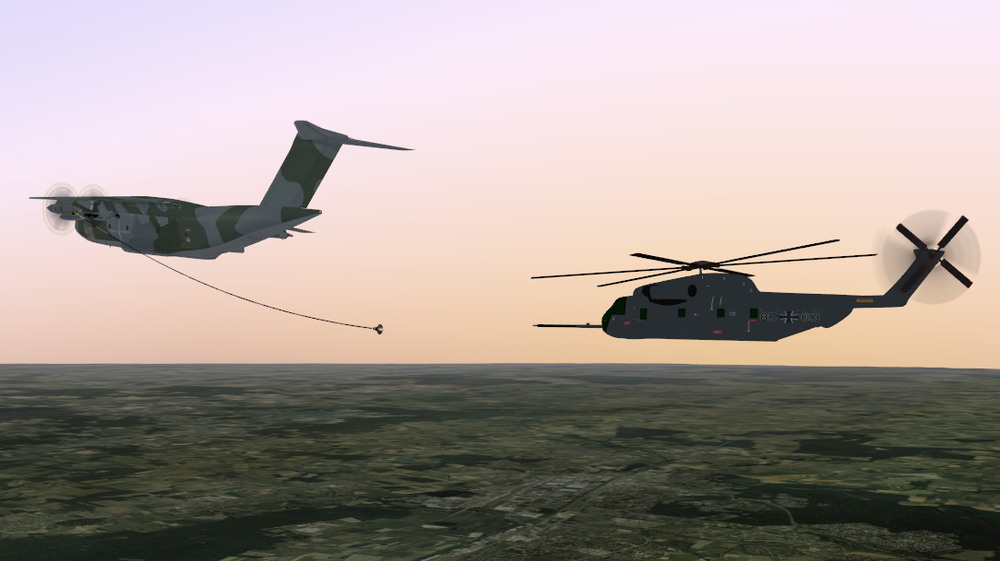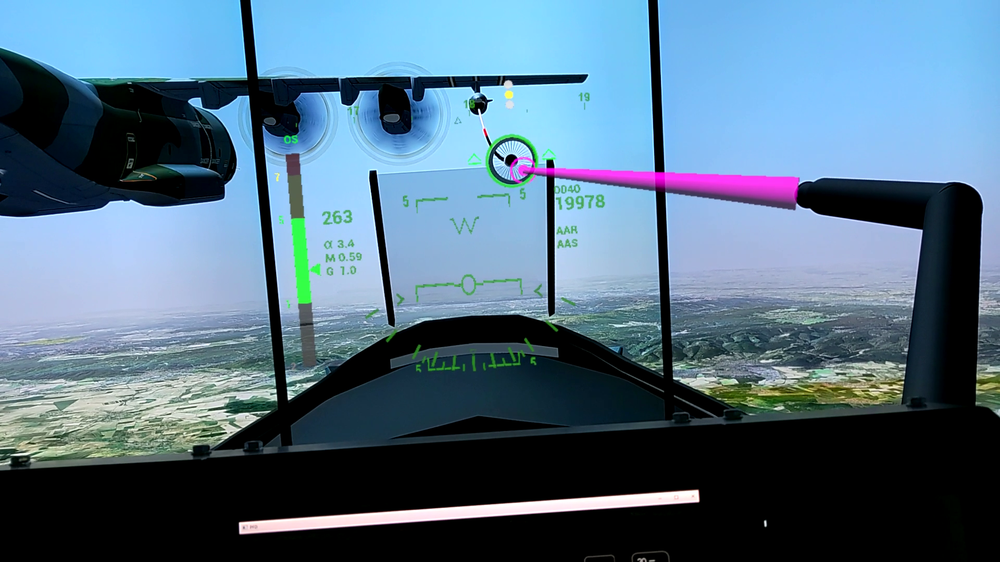Flight control and automation
Flight control and automation play a crucial role in modern aviation technology. They contribute significantly to improving the safety, efficiency and performance of aircraft. Innovative technologies are used to optimise complex flight manoeuvres and minimise the risk of malfunctions.
Research in this area focuses on the development of new control methods and systems that can be used in both manned and unmanned aircraft. The aim is to improve human-machine interaction and drive forward automation in aviation in order to enable safer and more efficient flight operations.
Automation of aerial refuelling manoeuvres
Aerial refuelling is a highly strategic capability for modern military operations as it allows extending the range and loiter time of the refuelled aircraft. This manoeuvre is very demanding for the pilots, who are subject to great stress and mental workload and require extensive and frequent training to master it. A refuelling procedure which is used across all receiver types (manned and unmanned fixed-wing aircraft and helicopters) is the probe-and-drogue method. With this method, the receiver aircraft establishes contact with a small refuelling basket that is trailing at the end of the refuelling hose.
The DLR Institute of Flight System investigates means to relieve the workload on pilots for instance through improved information processing, optimised control modes and partial or full automation of the aerial refuelling. To this aim, high-quality refuelling simulations comprising models of tanker and receiver aircraft, of the refuelling systems, of the sensors and of the interactions between these vehicles and components (e.g. tanker wake and its impact on the receiver, receiver bow-wave and contact between probe and drogue) have been developed. This research is supported by experimental activities such as piloted simulation campaigns with fighter, transport aeroplane and helicopter pilots as well as scaled flight demonstrations of active drogue with fixed-wing UAVs.
Flight control and automation of rotorcraft
The Institute of Flight Systems investigates topics in the field of flight control and automation of manned and unmanned rotorcraft systems. The research focuses on classical helicopter configurations with main and tail rotors, coaxial helicopters, helicopters with Flettner configuration and new rotorcraft configurations that have additional rotors and propellers to generate thrust and lift as well as additional aerodynamically effective lifting and control surfaces. The team develops and tests flight control systems of varying complexity, ranging from simple SAS systems (SAS - Stability Augmentation System) to autopilot functions, model following control and model predictive control, to fully automatic trajectory following control (including automatic obstacle avoidance) with the aim of making scientifically sound contributions and the long-term vision of enabling autonomous flight, including manned rotorcraft systems, in the future.
Reduction of Structural Loads Due to Atmospheric Disturbances
The Institute of Flight Systems investigates key enabling technologies that support the future development of lightweight, high-aspect-ratio wings. Through their improved aerodynamic-efficiency-to-weight ratio, these next-generation wings will significantly contribute to improving the climate impact of aviation, its economics as well as passenger comfort and safety when flying through turbulence.
To this end, DLR develops advanced sensors (e.g. Direct Detection UV Doppler Lidar), novel actuators (e.g. electro-mechanical actuators), and customised control design methods applicable for large aircraft models and industry-size problems. The institute does not only investigate individual functions such as gust and manoeuvre load alleviation, flutter control, manual/autopilot modes but also their integration and potential interactions.
A wide range of multi-fidelity design tools, simulations, hardware-in-the-loop testbenches and flight test platforms are used for this purpose. To maximise the impact of this research and facilitate its industrialisation, the required evolution of the certification rules and means of compliance are also an integral part of this research.
Development and validation of novel flight control methods
Innovative flight control methods make a significant contribution to increasing the safety, efficiency, and automation of conventional aircraft. At the same time they enable new applications such as electric vertical take-off and landing aircraft (eVTOL) and high-altitude long-endurance aircraft (HALE). In addition to the development of control methods, the Institute of Flight Systems also conducts research in the field of advanced tool chains and methods that provide comprehensive support for the development process. The aim is to increase the Technology Readiness Levels (TRL) of new systems while ensuring a high level of safety and functionality.
These developments are based on physical models, non-linear simulations and motion simulations which enable the virtual testing, optimisation and investigation of control strategies even before physical prototypes exist. Building on this, the control systems are validated in flight tests with unmanned and manned aircraft. The successful first flights of the INDI (Incremental Non-linear Dynamic Inversion), LPV (Linear Paramer Varying) and Reinforcement Learning methods on a passenger aircraft are examples for this.
Optimization-based Clearance of Flight Control System Functions
The software MOPS (Multi-Objective Parameter Synthesis) is developed and applied in the institute for solving multi-objective optimization problems, which may originate from control design, systems engineering or also optimal control. Solution strategies like weighted min-max optimization or Pareto-optimal solvers thereby help to find compromise solutions for complex design problems. Thus, MOPS covers the whole range of tasks necessary for optimal systems design as well as validation and verification (clearance) activities.
These can be anti-optimization to identify possible critical system states (worst cases), followed by multi-model/case optimization for finding solutions (e.g. controllers) that are robust w.r.t. the worst cases and verification of the found solutions, e.g. via Monte-Carlo simulation.
A flexible and user-friendy implementation in the end allows to employ MOPS with a wide range of tools for systems design and simulation.


